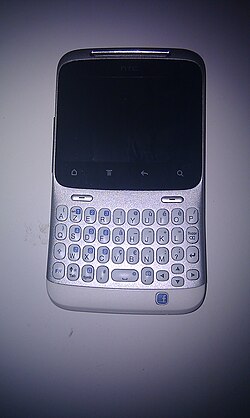The Motorola MPx200 smartphone was launched in December 2003 as a joint venture between Motorola and Microsoft. The mobile phone's Windows Mobile for Smartphone OS allows users to access email and the Internet, use MSN Messenger, and view documents in Microsoft Office formats much like other Windows smartphones such as the Samsung SGH-i600 or HTC Tanager. The MPx200, along with the Samsung SCH-i600, were the first Windows Mobile smartphone devices to have wide distribution in the United States. Previously, smartphone platform devices could only be purchased in the United States as part of development kits sold by Microsoft. The only U.S. carrier of the phone was AT&T Wireless; however, reports also suggest a somewhat limited number of devices with Cingular branding have appeared following the purchase of AT&T Wireless by Cingular.
The O2 Xda brand was a range of Windows Mobile PDA phones, marketed by O2, developed by O2 Asia and manufactured by multiple OEMs (mainly HTC, Quanta and Arima). The first model was released in June 2002. The last models came to market in 2008. The "X" represents convergence of voice and information/data within one product; the "DA" stands for "Digital Assistant", as in PDA. The name of XDA Developers is derived from it.

The HTC Universal is a Windows Mobile 5.0 Pocket PC PDA manufactured by High Tech Computer Corporation. It was the first 3G/UMTS-enabled Pocket PC PDA with a telecommunications function, and also the first to come with Windows Mobile 5.0 pre-installed.
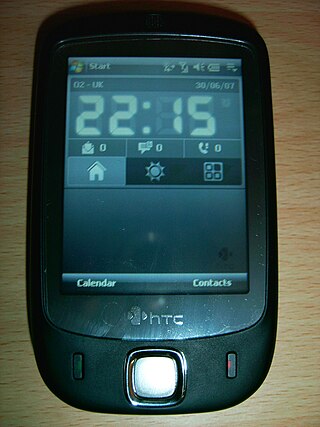
The HTC Touch, also known as the HTC P3450 or its codename the HTC Elf or the HTC Vogue for the CDMA variant, is a Windows Mobile 6-powered Pocket PC designed and manufactured by HTC. Its main, unique feature is a user interface named TouchFLO that detects a sweeping motion and can distinguish between a finger and a stylus. TouchFLO incorporates stylus-free access to a music player, a photo album, a video player and a picture-based contact book. The global launch of the Touch was in Leicester Square, London, on 5 June 2007, and the phone was initially available in two colours: black and green. The carrier bound names for this phone include Verizon Wireless XV6900, T-Mobile MDA Touch, O2 XDA Nova, Okta Touch and Vodafone VPA Touch.

The HTC Touch Pro is a smart phone from the Touch series of Internet-enabled Windows Mobile Pocket PC smartphones designed and marketed by HTC Corporation of Taiwan. It is an enhanced version of the HTC Touch Diamond with the addition of a left-side slide-out QWERTY keyboard, a microSD card slot, and a camera flash. The Touch Pro smartphone's functions include those of a camera phone and a portable media player in addition to text messaging and multimedia messaging. It also offers Internet services including e-mail, instant messaging, web browsing, and local Wi-Fi connectivity. Depending on its market, it is a quad-band GSM or quad-band UMTS phone with GPRS, EDGE, UMTS, HSDPA, and HSUPA or a tri-band CDMA phone with 1xEV-DO Rev A. All versions feature TouchFLO 3D — a new enhanced version of the TouchFLO interface, unique only to the latest Touch series. In March 2009, HTC announced a new version, the Touch Pro2 which has a larger screen (3.6") and a redesigned slide out QWERTY keyboard with spaces between the keys.

The HTC Dream is a smartphone developed by HTC. First released in October 2008 for $179 with a 2-year contract to T-Mobile, the Dream was the first commercially released device to use the Linux-based Android operating system, which was purchased and further developed by Google and the Open Handset Alliance to create an open competitor to other major smartphone platforms of the time, such as Symbian, BlackBerry OS, and iPhone OS. The operating system offers a customizable graphical user interface, integration with Google services such as Gmail, a notification system that shows a list of recent messages pushed from apps, and Android Market for downloading additional apps.
The HTC Touch Viva is a Windows Mobile smartphone developed by the High Tech Computer Corporation of Taiwan. Part of the HTC Touch Family, it incorporates quad band GSM, as well as the proprietary TouchFLO 3D user interface developed by HTC.
The Android Dev Phone (ADP) is a SIM-unlocked and bootloader unlocked Android device that is designed for advanced developers. While developers can use regular consumer devices purchased at retail to test and use their apps, some developers may choose not to use a retail device, preferring an unlocked or no-contract device.

The Samsung Moment, known as SPH-M900, is a smartphone manufactured by Samsung that uses the open source Android operating system.
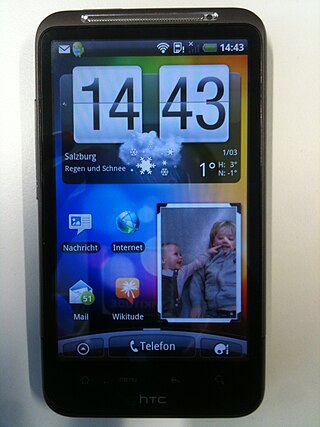
The HTC Desire HD is an Android smartphone by HTC Corporation. It was unveiled at a press event in London hosted by HTC on September 15, 2010, and was made available for sale in October in Europe and in January 2011 in Canada. The Desire was HTC's fourth flagship Android device until the release of their new line of flagship model, the HTC Sensation.
The Samsung Infuse 4G was an Android smartphone that was released by Samsung in May 2011. It has a 1.2 GHz Hummingbird processor with 8–16 GB internal Flash memory, a 4.5 inch 480×800 pixel Super AMOLED Plus capacitive touchscreen display, an 8-megapixel camera and a 1.3-megapixel front-facing camera.

The Motorola Flipout is a phone made by Motorola and released in June 2010. Its touchscreen is 2.8 inches in size. It also has a 3.2-megapixel camera and comes in a wide variety of colors such as "Poppy Red", "Brilliant Blue″, "Licorice Black", "White", and "Saffron". However, in Australia, only "Poppy Red" and "Licorice Black" are available. The Flipout runs on Android 2.1. Its square-shaped body has two parts that rotate near the bottom-right corner to reveal a five-row QWERTY keyboard below the screen. It has an accelerometer and includes a web browser with Adobe Flash Lite 3.0. It also has a 720 MHz processor with a QVGA 320x240 pixel display.

The Samsung Galaxy Mini (GT-S5570[B/L/i]) is a smartphone manufactured by Samsung that runs the Android operating system. It was announced and released by Samsung in early 2011. In some markets it is known as Samsung Galaxy Next/Pop/NG, while it is sold in the United States as the Samsung Dart exclusively for T-Mobile. It is currently available in four different colors; steel grey, white, lime and orange. With this release, the face buttons were changed to capacitive touch, matching the rest of the Galaxy lineup.

The LG Optimus 3D is a 3D-enabled Android 2.2 Froyo 3D mobile device released on 7 July 2011 in the UK and advertised as the world's first full 3D mobile phone. It has 512 MB of RAM and 8 GB of onboard storage, which can be expanded by up to 32 GB using a micro SDHC card. The phone features two 5 MP back-facing cameras that are capable of filming 720p 3D and Full HD 1080p in 2D, while pictures taken in 2D mode are 5 MP and 3 MP when taking a 3D picture. It also includes a VGA front-facing camera for video-calling. The phone features a 3D user interface which allows the users to access 3D content, such as YouTube in 3D, 3D games and apps, or 3D gallery with a push of a button.
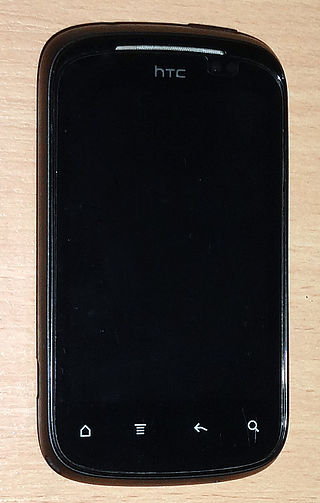
The HTC Explorer, code-named Pico, is a smartphone developed by the HTC Corporation that was released in October 2011. Because of the low end processor, the HTC Watch movie rental service and the 3D scrolling effects on the home screens were not available. The handset was available in four varieties of color options. Visually similar to the HTC Wildfire S, it comes with a 3.2-inch screen, a 600 MHz ARMv7 Qualcomm Snapdragon processor and runs Android version 2.3 (Gingerbread), bundled with the proprietary HTC Sense 3.5 user interface.

The Sony Ericsson Xperia mini is an Android smartphone from Sony Ericsson, released in August 2011. The Xperia mini has a "mobile BRAVIA engine" driving a 320×480 pixels 3-inch (76 mm) capacitive touch-screen, a 1 GHz Snapdragon S2 processor, a 5 megapixel camera, 512 MB of onboard RAM, and comes stock with a 2 GB microSD card. The phone is one of Sony Ericsson's environmentally friendly "Greenheart" range, featuring devices made of recycled materials, longer battery life and low-energy chargers, as well as minimal use of paper through reduced packaging and the replacement of the traditional printed user manual with one stored on the phone.

Samsung Galaxy Y (GT-S5360) is an Android-based smartphone by Samsung, announced in August 2011. Its main features are 3G connection with speeds up to 7.2 Mbit/s and Wi-Fi.
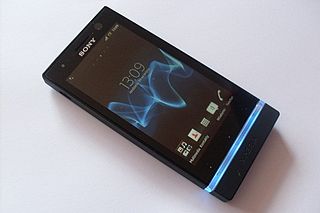
The Sony Xperia U ST25i, codenamed Kumquat during its development, is an Android smartphone from Sony. It was launched at the 2012 Mobile World Congress held in Barcelona, and is the second Sony-only branded smartphone after Sony acquired Ericsson's stake in Sony Ericsson in January 2012. The Xperia U has a 3.5-inch (88.9 mm) touch-screen with the mobile BRAVIA engine which optimises the picture, a 1 GHz dual core processor, a 5 mega-pixel rear camera, 0.3 mega-pixel front camera, 512 MB of RAM, and 8 GB of internal storage. The cap at the bottom of the phone is interchangeable. The phone is shipped with four caps: pink, white, yellow and black.
The HTC Salsa is an Android smartphone that was announced by HTC in June 2011 at the Mobile World Congress.

Samsung Galaxy Ace 2 (GT-I8160) is a smartphone manufactured by Samsung that runs the Android operating system. Announced and released by Samsung in February 2012, the Galaxy Ace 2 is the successor to the Galaxy Ace Plus.
